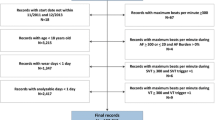Abstract
Pacemaker telemetry is increasingly being used to infer the presence or absence of arrhythmias in clinical practice. To evaluate the reliability of these data in patients with sick-sinus syndrome, a sub-study of eighteen consecutive patients in the Systematic Trial of Pacing to prevent Atrial Fibrillation (STOP AF) implanted with dual-chamber pacemakers had simultaneous 24-hour Holter recordings and pacemaker telemetry down-loaded. Whilst heart rate data were very similar, telemetry data achieved only 57% sensitivity with 64% specificity for the presence of atrial fibrillation on Holter recording over 24 hours. False-positive results were due to far-field sensing while false-negatives were seen with very short episodes of atrial fibrillation. The pacemaker's anti-tachycardia responses were not specific for the detection of atrial fibrillation.
There are very few published reports correlating pacemaker diagnostic data and stored electrograms with external Holter monitoring. We believe that more validation studies of are needed before pacemaker diagnostic data can be used with confidence in clinical practice. It is unlikely that current devices with sophisticated detection algorithms will fail to detect prolonged episodes of arrhythmia and their capacity to confirm events with stored electrograms, intervals and markers reduces the possibility of false-positives, but care must be taken in the interpretation of stored data from devices without these capabilities. Equally, it cannot be assumed that if intracardiac electrograms from one episode confirm the presence of an arrhythmia, that all recorded events have been similarly correctly interpreted.
We have shown in a sub-study of STOP-AF that simple mathematical models using heart rate bin analysis are not reliable for detection of arrhythmias with short durations. Despite these limitations, the potential of implanted pacemakers to record cardiac rhythm and trends, such as heart-rate variability, over time remains an exciting prospect, particularly in guiding individual patient therapy.
Similar content being viewed by others
References
Charles RG, McComb JM. Systematic trial of pacing to prevent atrial fibrillation (STOP-AF). (editorial). Heart 1997;78:224–225.
Plummer CJ, Henderson S, Gardener L, McComb JM. The use of permanent pacemakers in the detection of cardiac arrhythmias. Europace 2001;3:229–232.
Causer J, Gribbin G, McComb J, Charles R, on behalf of the STOP-AF Investigators. The systematic trial of pacing in the prevention of AF (STOP-AF): Early incidence of AF and AV disease. Arch Mal Coeur 1998;91:237.
Gillis A, Wyse D, Connolly S, Dubuc M, Philippon F, Yee R, Lacombe P, Rose M, Kerr C, for the Atrial Pacing PeriAblation for Paroxsmal Atrial Fibrillation (PA3) Study Investigators. Atrial pacing periablation for the prevention of paroxysmal atrial fibrillation. Circulation 1999;99:2553–2558.
Gillis AM, Rose MS. Temporal patterns of paroxysmal atrial fibrillation following DDDR pacemaker implantation. Am J Cardiol 2000;85:1445–1450.
Glotzer TV, Hellkamp AS, Zimmermann J, Sweeney MO, Yee R, Marinchak R, Cook J, Paraschos A, Love J, Radoslovich G, Lee KL, Lamas GA, for the MOST Investigators. Atrial high rate episodes detected by pacemaker diagnostics predict death and stroke Report of the atrial diagnostics ancillary study of the Mode Selection Trial (MOST). Circulation 2003;107:1614–1619.
Fauchier L, Briand F, Soto F, Quennelle F, Levy J, Darmon J, Lellouche D, Lavergne T, Poret P, Pelade C, Babuty D. Management of atrial tachyarrhythmias: Benefits of pacemaker diagnostics. PACE 2003;26:233–238.
Leung S-K, Lau C-P, Lam C-F, Tse H-F, Tang M-O, Chung F, Ayers G. Programmed atrial sensitivity: A critical determinant in atrial fibrillation detection and optimal automatic mode switching. PACE 1998;21:2214–2219.
Seidl K, Meisl E, VanAgt E, Ottenhoff F, Hess M, Hauer B, Zahn R, Senges J. Is the atrial high rate episode diagnostic feature reliable in detecting paroxysmal episodes of atrial tachyarrhythmias? PACE 1998;21:694–700.
Walfridsson H, Aunes M, Capocci M, Edvardsson N. Sensing of atrial fibrillation: How should atrial sensing be programmed to ensure adequate mode shifting. PACE 2000;23:1089–1093.
Defaye P, Dournaux F, Mouton E. Prevalence of supraventricular arrhythmias from the automated analysis of data stored in the DDD pacemakers of 617 patients: The AIDA study. PACE 1998;21:250–255.
Gillis AM, Morck M. Atrial fibrillation after DDDR pacemaker implantation. J CArdiovasc Electrophysiol 2002;13:542–547.
Pollak WM, Simmons JD, Interian A, Atapattu SA, Castellanos A, Myerburg RJ, Mitrani RD. Clinical utility of intraatrial pacemaker stored electrograms to diagnose atrial fibrillation and flutter. PACE 2001;24:424–429.
Israel CW, Ehrlich JR, Gronefeld G, Klesius A, Lawo T, Lemke B, Hohnloser SH. Prevalence, characteristics and clinical implications of regular atrial tachyarrhythmias in patients with atrial fibrillation. JAmColl Cardiol 2001;38.
Defaye P, Leclercq J-F, Guilleman D, Scanu P, Hazard J-R, Fatemi M, Boursier M, Lambiez M, on behalf of the EGM Study Group. Contributions of high resolution electrograms memorized bt DDDR pacemakers in the interpretation of arrhythmic events. PACE 2003;26:214–220.
Nowak B, Kracker S, Rippin G, Horstick G, Vincent A, Geil S, Himmrich E, Meyer J. Effect of the atrial blanking time on the detection of atrial fibrillation in dual chamber pacing. PACE 2001;24:496–499.
Sacks S, Mouton E, Defaye P, Dagres N, Wolfhard U, Wieneke H, Herrmann J, Oldenburg O, Golles A, Erbel R, AIDA Multicenter Study Group. Improved detection and analysis of sensed and paced events in dual chamber pacemakers with extended memory function. Prospective multicenter trial in 626 patients. Herz 2001;26:30–39.
Fitts S, Hill M, Mehra R, Gillis A, investigators ftPCt. High rate atrial tachyarrhythmia detections in implantable pulse generators: Low incidence of false positive detections. PACE 2000;23:1080–1086.
Lee MA, Weachteer R, Pollak S, Kremers MS, Naik AM, Silverman R, Tuzi J, Wang W, Johnson LJ, Euler DE, for the ATTEST Investigators. The effect of atrial pacing therapies on atrial tachyarrhythmia burden and frequency. J Am Coll Cardiol 2003;41:1926–1932.
Author information
Authors and Affiliations
Rights and permissions
About this article
Cite this article
Plummer, C., McComb, J. Detection of Atrial Fibrillation by Permanent Pacemakers: Observations from the STOP AF Trial. Card Electrophysiol Rev 7, 333–340 (2003). https://doi.org/10.1023/B:CEPR.0000023133.43829.9a
Issue Date:
DOI: https://doi.org/10.1023/B:CEPR.0000023133.43829.9a




